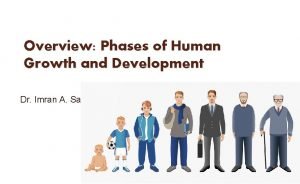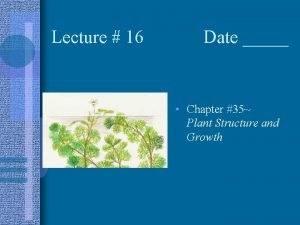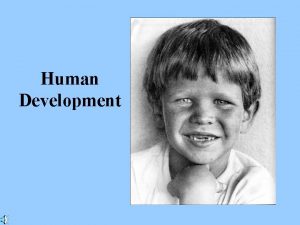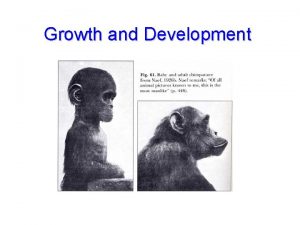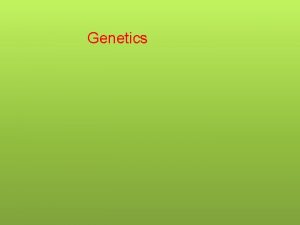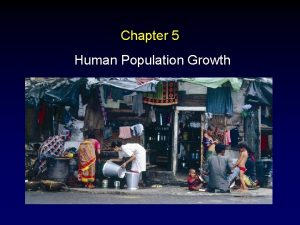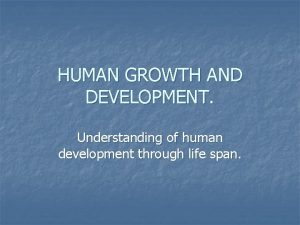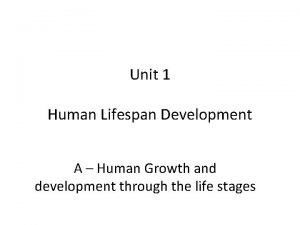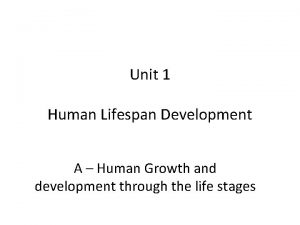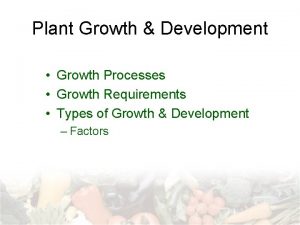Unit 6 Human Growth Development Chapter 16 Lesson













- Slides: 13

Unit 6: Human Growth & Development Chapter 16 Lesson 1 - Endocrine System Lesson 2 – Male Reproductive System Lesson 3 – Female Reproductive System

Endocrine System • The endocrine system is the collection of glands that produce hormones that regulate metabolism, growth and development, tissue function, sexual function, reproduction, sleep, and mood, among other things. Pituitary- controls activities of all other glands • Ovaries/Testes(reproductive glands)MASTER GLAND Hypothalamus- links endocrine to nervous system; Glands that store/produce the reproductive triggering pituitary to secrete appropriate hormones cells; control secondary sex characteristics Pineal- sleep (melatonin) Thyroid- regulate metabolism (thyroxine) during puberty; secrete Thymus- regulates development of immune system estrogen/testosterone Adrenal- controls body’s emergency response Pancreas- regulates blood glucose (insulin)

REPRODUCTIVE SYSTEM • All living things reproduce. Reproduction — the process by which organisms make more organisms like themselves — is one of the things that set living things apart from nonliving matter. But even though the reproductive system is essential to keeping a species alive, unlike other body systems it's not essential to keeping an individual alive. • In the human reproductive process, two kinds of sex cells, or gametes (pronounced: GAH-meetz), are involved. The male gamete, or sperm, and the female gamete, the egg or ovum, meet in the female's reproductive system to create a new individual. Both the male and female reproductive systems are essential for reproduction.

Male Reproductive System Lesson 2 (pg. 446) The 2 main functions of the male reproductive system are to 1. produce and store sperm- male gamete, or reproductive cells 2. Transfer them to females body during intercourse Hormones produced in pituitary stimulate production of testosterone-male sex hormone to signal *growth and maturity *production of sperm After puberty begins, a physically mature…healthy male is capable of producing sperm for the rest of his life for reproduction

Male Reproductive Overview • Male Reproductive System • http: //kidshealth. org/teen/sexual_health/guys/male_repro. html • At puberty, the male reproductive system begins and will continue to function throughout the remainder of the male's life. The basic steps in the function of the male reproductive system are: • Sperm are produced in the testes (testicles) located in the scrotum. • Sperm travel to the epididymis to mature. • At ejaculation sperm move through the vas deferens (ductus deferens) • Sperm will combine with fluids from the seminal vesicles, prostate gland, and Cowper's glands to form semen. • Semen containing the sperm will travel through the urethra in the penis. • If introduced to the female, sperm will travel throughout the female's body in search of an ovum

Male Reproductive Structures A- Median section thru pelvis B- Anterior view 1. Vas deferens 2. Seminal vesicle 3. Prostate gland 4. Cowper’s glands 5. Epididymis 6. Testes 7. Scrotum 8. Penis 9. Pubic symphysis 10. Bladder 11. Urethra 12. Anus

Functions of Male Reproductive Organs/Structures 1. Vas deferens-tubes that extend from each epididymis to the urethra 2. Seminal vesicle-produces secretions that combine with sperm 3. Prostate gland-produces fluid that nourishes the sperm and makes them more mobile 4. Cowper’s glands(2)-small glands that sit just below the prostate and secrets fluid to lubricate & clean the urethra 5. Epididymis-coiled tube where sperm mature and are stored 6. Testes (testicles)-two small gland that secrete testosterone and produce sperm 7. Scrotum-external skin sac 8. Penis-tube shaped organ that extends from the trunk of the body just above the testes 9. Pubic symphysis-Ligament attached to the pubic bone (protection of bladder) 10. Bladder-muscular sac in pelvic region that stores urine 11. Urethra-passage way through which semen and urine leave the body

Female Reproductive System Lesson 3 (pg. 452) The female reproductive system has several functions 1. Produce female sex hormone-estrogen 2. Storing of the female eggs (gametes)- ova/ovum 3. Enable pregnancy to occur with first monthly ovulation-process of releasing a mature ovum Menstruation- shedding of the uterine lining Endometrium- tissue that lines the uterus (Endometriosis)-when uterine tissue grows in the ovaries, fallopian tubes, or lining of the pelvic cavity.

Female Reproductive Overview • • Female Reproductive System http: //kidshealth. org/teen/sexual_health/girls/female_repro. html The female's reproductive system differs from the males in that the reproductive period is limited from puberty until menopause. Unlike the male, who is capable of fathering a child well into his later years, the female has a limited window of reproductive opportunity. At birth, the female ovaries contain all of the eggs her body will ever produce. At puberty, eggs will be released, one at a time, alternating from ovary to ovary in a monthly cycle known as menstruation. This process will continue until hormone levels begin to decrease and all the viable eggs have been released. This usually occurs during middle age and is called menopause. The steps in the female reproductive cycle are listed below: Egg (ovum) matures in the ovary as the endometrium or lining of the uterus thickens. Egg erupts from the ovary (ovulation) and is pulled by the fringe into the Fallopian tube. Ovulation alternates from one ovary to the next each month. The egg travels through the Fallopian tube until it reaches the uterus. If fertilized, the egg will eventually attach or implant itself into the wall of the uterus and the pregnancy will progress. If not fertilized, the egg will be discharged from the females's body along with the broken down endometrium, past the cervix and through the vagina (birth canal) in the menstrual flow.

Female Reproductive Structures A – Median section thru pelvis B- Anterior view 1. Ovary 2. Fallopian Tube 3. Uterus 3 a. Cervix 4. Vagina 5. Urethra 5 a. Clitoris 6. Labia magora 7. Labia minora 8. Pubic symphysis 9. Bladder 10. Anus 11. Perineum

Female Reproductive Organs/Structures 1. Ovary(ovaries)- gland that stores the ova, or eggs, and produce estrogen 2. Fallopian tube – tubes that draw out and carry the ovum 3. Uterus- hollow, muscular, pear-shaped organ that nourishes and protects a fertilized ovum until birth 3 a. Cervix – the opening to the uterus 4. Vagina- passageway that extends from the uterus to the outside of the body (birth canal) 5. Urethra- structure that urine is eliminated through 5 a. Clitoris- sensitivity center (over 8, 000 nerve endings) 6. Labia majora – protects other external structures (fatty tissuecomparable to scrotum in male) 7. Labia minora-smaller structure just inside the labia magora and protects the opening of the vagina 8. Pubic symphysis-Ligament attached to the pubic bone (protection of bladder) 9. Bladder -muscular sac in pelvic region that stores urine 10. Anus – external opening of the rectum (eliminates solid waste) 11. Perineum- structure between the anus and vagina episiotomy

Maintaining Reproductive Health Male Females Reproductive Health • Bathe regularly • Wear protective equipment • Practice abstinence • Perform regular self exams • Get regular check ups Reproductive Problems • Inguinal hernia-part of the intestines • Sterility-inability to reproduce • Testicular cancer • Prostate problems/cancerenlarged, infected, tumor Reproductive Health • Bathe regularly • Practice abstinence • Perform regular self exams • Get regular check ups Reproductive Problems • • Menstrual cramps Premenstrual syndrome(PMS) Toxic shock syndrome (TSS)-bacterial infection (immune system and liver) Endometriosis STD-Sexually Transmitted Disease Vaginitis-yeast or bacterial infection Ovarian cysts-non cancerous Cancer/ cervical, uterine, ovarian

Additional Vocab • Abstinence- a deliberate decision to avoid high-risk behaviors, including sexual activity, alcohol, tobacco, and other drug use. • Puberty-period of time when a person develops traits of adults for his/her gender Exact age is determined primarily by heredity… 12 -15 yrs. and gradually unfold over several months or years • Adolescence- the period between childhood and adulthood • Fertilization-the union of a male sperm cell and female egg
 Chapter 7 human growth and development
Chapter 7 human growth and development Chapter 16 lesson 2 the male reproductive system
Chapter 16 lesson 2 the male reproductive system Human needs and human development chapter 8
Human needs and human development chapter 8 Chapter 8 human needs and human development
Chapter 8 human needs and human development Stages of human growth and development pictures
Stages of human growth and development pictures Growth and development principles
Growth and development principles Human growth and development
Human growth and development Late childhood mental development
Late childhood mental development Social changes in late adulthood
Social changes in late adulthood Gni definition ap human geography
Gni definition ap human geography Chapter 35 plant structure growth and development
Chapter 35 plant structure growth and development Chapter 35 plant structure growth and development
Chapter 35 plant structure growth and development Growth is defined as an increase in
Growth is defined as an increase in Ground tissue
Ground tissue






